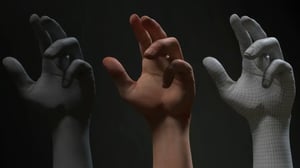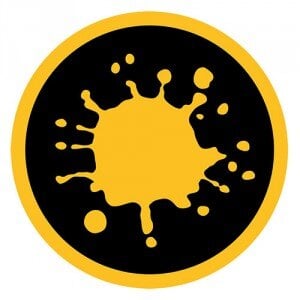
Texture Artist
Student work by Andi Edirisinghe
TABLE OF CONTENTS
What does a texture artist do?
Texture artists specialize in creating the textures of 3D models. They require a biological understanding of skin in humans and animals, as well as a knowledge of textiles, geographic elements, architectural finishes, landscapes, etc.
With games now requiring more photo-realistic finishes these days the role of the Texture Artist is increasing in importance. In line with this trend, some of the work of the Texture Artist involves scanning photographs and then applying them to objects and environments created by the 3D Modelers.
Custom textures are created for fantasy environments, objects and creatures but they are always rooted in reality. Covering gaming worlds in a variety of surfaces prevents boredom and enhances gameplay.
Gaming Texture Artists work closely with modelers and shading/lighting technical directors to create the best possible elements for the game universe.
Texture Artists in live action film and 3D animation features create textures for the elements of the productions that require complex texturing. In live action productions this will be more photo-realistic as it must integrate seemlessly with the footage, and sometimes replicate surfaces that exist in real life.
Texture artist job description
The role of the gaming Texture Artist is to recreate realistic or fantastical textures or surfaces to characters or objects. They specialize in all surface qualities of 3D computer models such as skins, flesh, textiles, armor, fur, hair, scales, metallic finishes, nails, claws, membranes, etc. This requires a broad knowledge of the skeletal framework and rigging that suspends and operates the models as the texturing must work as a layer on top of moving parts.
Textures are created from scratch or from real world references using scans which are imported and fashioned into graphics elements. With gaming graphics becoming ever more sophisticated the Texture Artist must deliver increasingly real and dynamic results.
The role of the Texture Artist in live action and animation is to create textures for 3D modeling throughout the production. Realism is the goal in live action sequences, while animation projects require consistency of visual style.
Role & responsibilities of a texture artist in film and games:
- Liaising with designers and developers regarding the design brief
- Liaising with the director, cinematographer, design department on the finishes of the texturing
- Researching reference materials for aesthetics and genre of game, film or animation
- Working with post production and visual effects teams for seamless integration with footage
- Develop and refine textures during the production process
- Collaborate with animators and modelers on the best textures for each object and character
- Create a diverse and compelling range of textures that will engage the player and enhance gameplay
- UV mapping
- Maintain a high level of design and photorealism throughout
- Curate a consistent look of all the elements of the game or film

How much does a texture artist make?
The role of a texture artist can be an entry-level or junior position. The average salary of a Texture Artist ranges from USD $62,000 to USD $112,000 Source: Glassdoor.
Skills required to become a texture artist
Any Texture Artist worth their salt will be constantly on the lookout for textures in the real world to bring into their work. They need to have a keen eye for detail as everything that surrounds them could be a reference point for a surface or character skin.
Video game and film studios may look for the following skills in a texture artist:
- Training in computer graphics, 3D animation, or graphic design
- Experience in texturing 3D models, knowledge of modeling rigs
- Ability to consistently draw inspiration from real-world references
- Solid understanding of visual language - texture, color, dimension, scale, perspective, shade, composition depth of field, proportion, lighting, spatial awareness, etc
- Fundamental understanding of anatomy
- Familiarity with geographical and botanical elements, architectural finishes, textile movement, skin and hair behavior, metallic sheens, etc
What software and tools do texture use?
Texture artists must know their way around the software used by 3D modelers, but also have more texture-specific programs that they work with.
Texture artists may need knowledge of a combination of the following software:

Maya is a comprehensive 3D animation software used for creating detailed models, animations, and visual effects. It's popular in film, TV, and game development for its powerful tools.

Maxon ZBrush is a digital sculpting tool that combines 3D/2.5D modeling, texturing and painting

Mari® is 3D painting without limits, combining the power and performance to handle even the most complex assets with artist-friendly 3D paint tools, that make the most of your creativity.

Substance Painter: The tools you need to texture your 3D assets, from advanced brushes to Smart Materials.

Adobe Photoshop is a raster graphics editor developed and published by Adobe for Windows and macOS. It was created in 1987 by Thomas and John Knoll

Mudbox is a proprietary computer-based 3D sculpting and painting tool. Currently developed by Autodesk, Mudbox was created by Skymatter
A day in the life of a texture artist
Working from concept art, real-world reference, and scans, 3D modelers and texture artists help make a film or game more dynamic, adding personality and emotion to its characters, constructing the overall realism of the story (even if done so stylistically), and assisting with world building.
With entertainment and technology veering towards augmented and virtual reality, and an increase in streaming services, the need for experienced texture artists will only rise.
How to become a texture artist
Increase your chances of getting hired with these strategies for success:
Download software
Try free 3D modeling programs like Blender, ZBrushCoreMini, or Houdini Apprentice. Otherwise, Autodesk Maya (industry standard) offers a free trial.
Build skills
Build the skills companies are listing on job sites. For more support, enroll in a reputable course. CG Spectrum’s courses include mentorship from 3D modeling pros and an industry-led curriculum.
Watch trends
Online tutorials, webinars, and events can help keep your skills fresh.
Network
Networking is vital. Familiarize yourself with the industry and build your community. Interact online and in real life with industry pros who might offer advice, insights, or job opportunities.
Intern
Internships at VFX or game studios can help you break into the industry. It’s one way to gain hands-on experience, network, and experience studio life.
Sell assets
Create and sell assets and texture packs on Unreal Engine Marketplace or similar to gain exposure, get feedback, demonstrate skills to potential employers and collaborators, and make money!
Collaborate
Know a rigger or modeler who needs texture work done? Collaborating with peers is fun and can produce polished work for your reel.
Join contests
Practice your skills and create assets for your reel by participating in contests and challenges on sites like The Rookies, ArtStation, and 3Dtotal.
Share work
Social media is great for showcasing work, building an audience, having your work shared by others, and seen by potential clients and collaborators.

Ready to Start Your Film & Games Journey?
Download our course guide to see how we can help you on your pathway to your dream career.Tips to break into the industry as a texture artist
Additional resources to help you get started as a texture artist for film and games:
- Read What is 3D modeling?
- Recommended reading list for 3D artists by CG Spectrum Mentor Bryan Mentor
- Check out Altruism Digital’s YouTube channel
- Watch How to sell your assets on Unreal Marketplace
- Download free assets on sites like Unreal Engine Marketplace, ProductionCrate, MegaScans,
AbientCG, Sketchfab, and TurboSquid and see how other people build their models - Use Anatomy for Sculptors’ free 3D écorché reference tool
- Join the Autodesk community and check out all their forums
- Blender also has a bunch of great communities you can join
- Explore ArtStation’s and 3Dtotal’s free modeling tutorials
- Visit the official Maya, ZBrush, and Houdini learning channels on YouTube
Demo reel tips:
- Tailor your reel to the studio and role you’re applying for
- Include scale reference to show your model is at the correct scale
- Where possible, show your model moving (e.g., via a turntable or rigged animation)
- If textured, render your model under different lighting conditions
- Use Vimeo for best video quality, plus you can update your video
- Embed your reel on a platform (like ArtStation) with high-res stills of your model’s best angles
- No studio experience: keep your reel < 1 min. 1–2 years experience: < 2 mins Work in progress is fine, but only include your best models
- Ensure music doesn’t distract from your work
- Double-check for errors; then check again
- Get feedback from at least 3 mentors or industry pros before finalizing
- Include reference footage, breakdowns, and credits where relevant
- Specify if your model is for animation, VFX, or games (each has different requirements)
- Share your reel on your website, ArtStation, LinkedIn, and other social channels
- Include any production experience

Industry Pathways
Bryan Bentley, 3D Modeling Curriculum Manager at CG Spectrum, shares how he broke into modeling almost by chance, from landing his first internship at the Jim Henson company to working at ILM on the Oscar-winning film Rango. Throughout, Bryan has nurtured his love for education and life-long learning.


